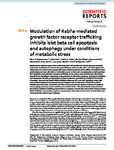Modulation of Rab7a-mediated growth factor receptor trafficking inhibits islet beta cell apoptosis and autophagy under conditions of metabolic stress
| dc.contributor.author | Hewawasam, NV | |
| dc.contributor.author | Lhaf, F | |
| dc.contributor.author | Taylor, HA | |
| dc.contributor.author | Viloria, K | |
| dc.contributor.author | Austin, A | |
| dc.contributor.author | King, A | |
| dc.contributor.author | Jones, P | |
| dc.contributor.author | Jones, L | |
| dc.contributor.author | Turner, MD | |
| dc.contributor.author | Hill, Natasha | |
| dc.date.accessioned | 2021-08-13T10:18:48Z | |
| dc.date.issued | 2020-09-25 | |
| dc.identifier.issn | 2045-2322 | |
| dc.identifier.issn | 2045-2322 | |
| dc.identifier.other | 15741 | |
| dc.identifier.uri | http://hdl.handle.net/10026.1/17577 | |
| dc.description.abstract |
<jats:title>Abstract</jats:title> <jats:p>Regenerative medicine approaches to enhancing beta cell growth and survival represent potential treatments for diabetes. It is known that growth factors such as insulin, IGF-1 and HGF support beta cell growth and survival, but in people with type 2 diabetes the destructive effects of metabolic stress predominate and beta cell death or dysfunction occurs. In this study we explore the novel hypothesis that regulation of growth factor receptor trafficking can be used to promote islet beta cell survival. Growth factor signalling is dependent on the presence of cell surface receptors. Endosomal trafficking and subsequent recycling or degradation of these receptors is controlled by the Rab GTPase family of proteins. We show that Rab7a siRNA inhibition enhances IGF-1 and HGF signalling in beta cells and increases expression of the growth factor receptors IGF-1R and c-Met. Furthermore, Rab7a inhibition promotes beta cell growth and islet survival, and protects against activation of apoptosis and autophagy pathways under conditions of metabolic stress. This study therefore demonstrates that Rab7a-mediated trafficking of growth factor receptors controls beta cell survival. Pharmaceutical Rab7a inhibition may provide a means to promote beta cell survival in the context of metabolic stress and prevent the onset of type 2 diabetes.</jats:p> | |
| dc.format.extent | 15741- | |
| dc.format.medium | Electronic | |
| dc.language | en | |
| dc.language.iso | en | |
| dc.publisher | Nature Research (part of Springer Nature) | |
| dc.subject | Animals | |
| dc.subject | Apoptosis | |
| dc.subject | Autophagy | |
| dc.subject | Cell Proliferation | |
| dc.subject | Cells, Cultured | |
| dc.subject | Diabetes Mellitus, Type 2 | |
| dc.subject | Hepatocyte Growth Factor | |
| dc.subject | Humans | |
| dc.subject | Insulin-Like Growth Factor I | |
| dc.subject | Insulin-Secreting Cells | |
| dc.subject | Islets of Langerhans | |
| dc.subject | Mice | |
| dc.subject | Protein Transport | |
| dc.subject | Proto-Oncogene Proteins c-met | |
| dc.subject | RNA, Small Interfering | |
| dc.subject | Receptor, IGF Type 1 | |
| dc.subject | Stress, Physiological | |
| dc.subject | Up-Regulation | |
| dc.subject | rab GTP-Binding Proteins | |
| dc.subject | rab7 GTP-Binding Proteins | |
| dc.title | Modulation of Rab7a-mediated growth factor receptor trafficking inhibits islet beta cell apoptosis and autophagy under conditions of metabolic stress | |
| dc.type | journal-article | |
| dc.type | Journal Article | |
| dc.type | Research Support, Non-U.S. Gov't | |
| plymouth.author-url | https://www.webofscience.com/api/gateway?GWVersion=2&SrcApp=PARTNER_APP&SrcAuth=LinksAMR&KeyUT=WOS:000577248100016&DestLinkType=FullRecord&DestApp=ALL_WOS&UsrCustomerID=11bb513d99f797142bcfeffcc58ea008 | |
| plymouth.issue | 1 | |
| plymouth.volume | 10 | |
| plymouth.publication-status | Published online | |
| plymouth.journal | Scientific Reports | |
| dc.identifier.doi | 10.1038/s41598-020-72939-y | |
| plymouth.organisational-group | /Plymouth | |
| plymouth.organisational-group | /Plymouth/Faculty of Health | |
| plymouth.organisational-group | /Plymouth/Faculty of Health/School of Biomedical Sciences | |
| plymouth.organisational-group | /Plymouth/Users by role | |
| plymouth.organisational-group | /Plymouth/Users by role/Academics | |
| dc.publisher.place | England | |
| dcterms.dateAccepted | 2020-09-09 | |
| dc.rights.embargodate | 2021-8-14 | |
| dc.identifier.eissn | 2045-2322 | |
| dc.rights.embargoperiod | Not known | |
| rioxxterms.versionofrecord | 10.1038/s41598-020-72939-y | |
| rioxxterms.licenseref.uri | http://www.rioxx.net/licenses/all-rights-reserved | |
| rioxxterms.licenseref.startdate | 2020-09-25 | |
| rioxxterms.type | Journal Article/Review |


